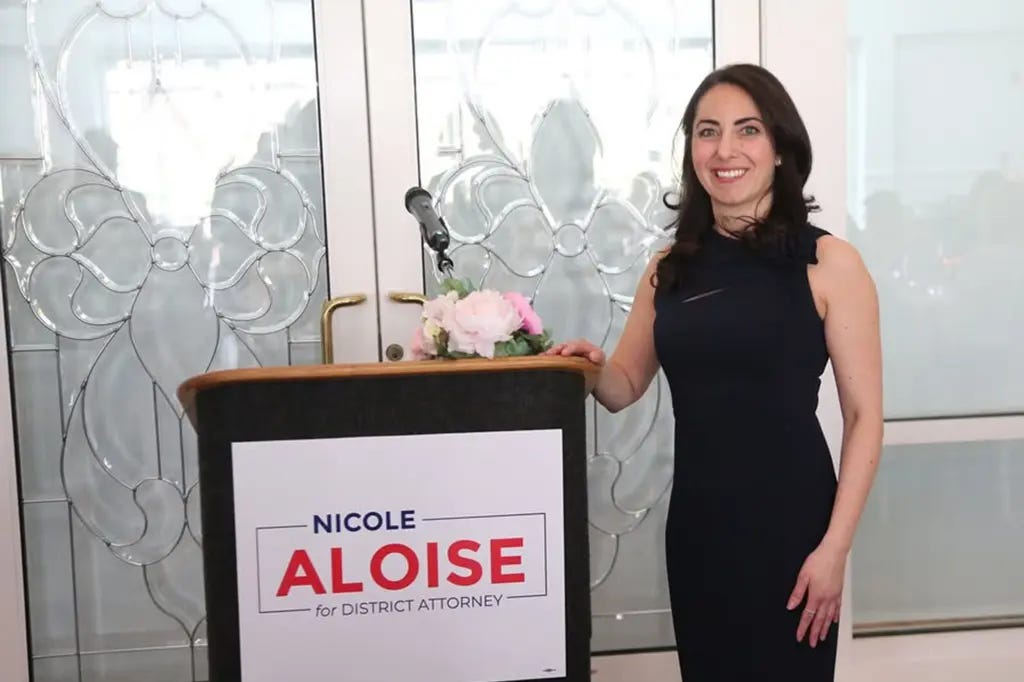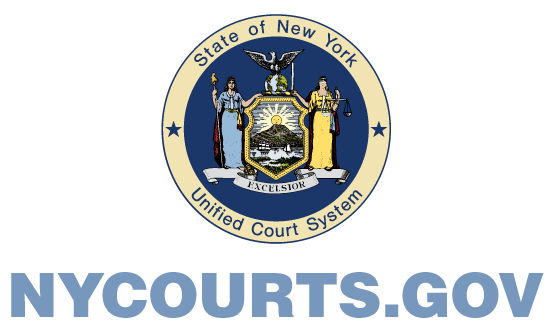Judgment Day For Judge Michael Aloise
Critics Urge the Forced Retirement of a Hack Queens Jurist with a Trail of Overturned Cases and Bias as He Seeks to Dodge the Mandatory Retirement Age.

NOTE: This piece first appeared on NYNewsPress.com.
By Richard Luthmann
Calls to Bench a Hack Judge
Chances are, if you stood before Justice Michael B. Aloise as a criminal defendant, you didn’t get a fair shake. Now, the longtime Queens Supreme Court judge, who turns 70 at year’s end, is facing judgment himself – and the judicial death penalty.
Under New York’s Constitution, state judges must retire in the year they hit 70, unless top court officials grant a two-year extension. Aloise has applied for such certification to remain on the bench, but a chorus of legal advocates is urging that he be shown the door.
In a rare public broadside, the nonprofit Center for Community Alternatives (CCA) sent a 12-page letter imploring the state’s Administrative Board to deny Aloise’s extension, citing “longstanding concerns with his record.” The CCA letter catalogs “dozens of cases” since 2009 in which higher courts reversed convictions or otherwise faulted Aloise’s rulings.
Advocates say this pattern of legal blunders and bias proves Aloise is unfit to serve a day longer.
“Justice Michael B. Aloise has repeatedly infringed defendants’ constitutional rights, including the rights to a fair and public trial, to present a complete defense, and to confront adverse witnesses,” said Peter Martin, CCA’s director of judicial accountability.
Martin urged court leaders “not to grant certification to Judge Aloise, who has made it clear after decades on the bench that he is unfit to continue to serve.”
The campaign to unseat Aloise marks an unusual push to hold a judge accountable at the twilight of his career, and it comes amid a broader debate over whether aging judges should stay on to ease case backlogs or step aside for the good of the public.
For Aloise, whose 27-year judicial tenure has been backed by Queens’ political establishment, the stakes are high as his once-assured golden years on the bench are suddenly under threat.
Judgment Day For Judge Aloise: Trail of Overturned Convictions
Critics call Aloise an outlier with a trail of trials gone wrong. According to court records and data compiled by the judicial transparency group Scrutinize, appellate courts have repeatedly smacked down Aloise’s decisions. Since Aloise became a Queens Supreme Court judge in 2004, at least 42 of his cases have been reversed or modified on appeal.
Higher courts have cited a litany of errors – from trampling defendants’ rights to botching jury instructions – that forced new trials and even freed prisoners early.
In one recent example, the New York Court of Appeals in May 2025 threw out a felony conviction after Aloise improperly denied a defendant the right to represent himself at trial.
In another case, an appellate panel reversed a murder conviction because Aloise had kicked a dozing friend of the defendant out of the courtroom – a move the judges said violated the defendant’s right to a public trial. That July 2025 decision admonished Aloise for excluding a spectator and “delaying what should have been a clear-cut conviction.”
Advocates note that each misstep means do-overs: costly retrials, wasted juror time, and years of delay for victims and defendants alike.
“Retrying entire felony cases…consumes enormous taxpayer resources,” Martin warned, adding that Aloise’s blunders have “denied closure not only to defendants, but to grieving families and the public.”
A review of Aloise’s record shows a judge repeatedly overruled by his peers. In case after case, appellate courts concluded he misapplied the law or overstepped his bounds.
He has been rebuked for undermining jury selection – for instance, refusing to dismiss jurors who admitted potential bias, which led to three defendants’ convictions being tossed in one 2015 trial. He’s also been faulted for faulty jury instructions that confused jurors and compromised verdicts.
In a 2024 case, Aloise’s failure to clarify a point of law resulted in a staggering 68 conviction counts being unanimously reversed. According to Scrutinize’s database, appellate courts have ordered new trials at least six times – twice just this year – after finding Aloise infringed fundamental rights in his courtroom.
When it comes to evidence suppression rulings, Aloise’s decisions are overturned on appeal at a rate of 12.3%, higher than 94.8% of judges statewide.
On sentencing, he has a notorious reputation for excess: appellate judges have sliced a combined 45 years off prison terms Aloise imposed, a reduction total that outstrips 99% of New York judges.
In one 2014 case, Aloise unlawfully tacked consecutive sentences on two counts stemming from the same incident – a basic legal error that a higher court had to fix. He repeated the exact mistake in 2020. All told, by CCA’s count, Aloise’s name appears in an array of appellate reversals spanning from 2009 to 2025, painting a picture of a jurist whose courtroom rulings often don’t survive a second look.
Judgment Day For Judge Aloise: Bias and Cozy Ties
Beyond the raw numbers, opponents argue that Aloise’s judicial missteps stem from a pronounced bias. They say his errors consistently favor one side: the prosecution.
“Judge Aloise has never met a criminal defendant he didn’t want to put away — unless that person had a badge,” veteran defense attorney Ron Kuby quipped, reflecting on Aloise’s reputation.
The CCA letter points to instances where Aloise’s conduct “called into question his impartiality” and “created a perception of bias against defendants and in favor of law enforcement.” Notably, Aloise has drawn fire for going easy on police accused of wrongdoing.
In a 2018 case, he stunned court observers by giving a light slap on the wrist to NYPD Detective Kevin Desormeau, who had been convicted of perjury for lying under oath. Prosecutors asked for six months behind bars, but Aloise was having none of it – he gave the disgraced detective probation and a $500 fine.
“This entire case disgusts the court,” Aloise scolded at the sentencing, accusing the district attorney’s office of “hypocrisy” in even seeking jail time. He went so far as to call the main civilian witness in that case “a bum,” effectively siding with the cop despite the jury’s guilty verdict.
Advocates say that kind of rhetoric – excoriating prosecutors and excusing police misconduct – underscores Aloise’s pro-law-enforcement leanings.
They also note the optics: during the high-profile trial of Chanel Lewis (convicted in the 2016 murder of Queens jogger Karina Vetrano), Judge Aloise raised eyebrows by wearing a purple tie in court, the color adopted by the victim’s family and supporters. To critics, it was yet another signal that the judge’s sympathies lay with the prosecution.
Aloise’s coziness with the law-and-order establishment isn’t just perceived – it’s personal. His own family is entwined. His daughter, Nicole Aloise, is running to become Nassau County District Attorney. Both she and her brother have worked for the Queens District Attorney’s Office for years.
The judge has even been photographed enjoying a Mets game at Citi Field with members of the Queens prosecutors’ association.
None of this is outright misconduct, but reformers say it exemplifies a clubby courthouse culture. When a judge’s closest kin and social circle are on the prosecution’s team, defendants worry the deck is stacked.
The appellate courts have occasionally shared that concern. In a 2016 case, the Second Department took the extraordinary step of removing Aloise from a post-conviction matter because his comments indicated he might “be predisposed to rule against the defendant.” That case involved a man seeking to withdraw a plea after learning he faced life in prison as a persistent felon. Aloise initially denied him relief, but the higher court not only reversed Aloise’s ruling but also reassigned the case to a different judge entirely.
CCA argues this rare rebuke highlights a deeper issue of partiality. They claim Aloise has long exhibited a pro-prosecution slant, from consistently disbelieving defense claims to imposing harsher sentences than warranted.
In their letter, advocates list multiple examples of Aloise doling out maximum penalties based on erroneous interpretations of the law – mistakes that appellate judges later corrected in the defendants’ favor. Such patterns, reformers say, betray the neutral role expected of a judge and instead evoke a jurist who acts like a second prosecutor on the bench.
The push to oust Aloise is striking because the judge has been a fixture of the Queens legal scene, with deep political roots. Aloise first ascended to the bench in the 1990s and won a seat on the Supreme Court in 2004 with the backing of the Queens Democratic machine. In an ever-increasing display of uni-party collusion, he was cross-endorsed by both Democrats and Republicans, virtually guaranteeing his election. (Queens party bosses have a long history of cutting deals to place favored candidates on the bench unopposed.)
Aloise easily won re-election in 2017 under multiple party lines as well. This establishment's support enabled him to enjoy a long tenure with minimal public scrutiny. After all, judges in New York are rarely household names.
Aloise earned a reputation as a tough sentencing judge and presided over headline-grabbing trials, such as the Vetrano jogger murder case. But until now, his occasional controversies stayed inside legal circles. With the CCA’s public broadside, Aloise’s name is splashed in the news – and not in a flattering light.
“Certification to serve as a judge beyond the mandatory retirement age is not a right,” Martin’s letter reminds court officials. The message is that Aloise’s connections and longevity shouldn’t shield him from accountability.
Judgment Day For Judge Aloise: Showdown Over Retirement
The decision on Aloise’s fate now lies with the Administrative Board of the Courts – a panel of five top judges headed by New York’s Chief Judge. They will review Aloise’s application for certification, along with about 40 other judges turning 70 who hope to continue serving. The board solicited public comment on each judge’s “ability, knowledge, and character,” a process usually shrouded in silence.
This time, however, reform advocates are making noise. Martin and his colleague Katie Schaffer seized the opportunity to file their damning letter, which they also shared with the press.
The public campaign means the board cannot ignore Aloise’s record. Observers say it’s rare for a judge’s dirty laundry to be aired so openly right before a recertification decision. But calls for greater transparency in the judiciary have been growing, emboldening groups like CCA to speak out. Just last year, CCA and allies successfully torpedoed the nomination of a controversial judge to New York’s highest court. Now they’ve trained their sights on keeping what they see as a problematic judge off the trial bench.
Aloise, for his part, has been publicly mum. His chambers referred inquiries to the Office of Court Administration, which declined to comment on the specifics of the case. A court system spokesman would only note generally that certification decisions are based on each judge’s performance and discretion under the law.
Meanwhile, some in the judiciary bristle at mandatory retirement as age discrimination. They argue that experienced judges like Aloise are still capable and badly needed to handle heavy caseloads. Indeed, the whole purpose of the certification system is to keep veteran jurists on the bench until as late as 76 to help with backlogs.
But reformers counter that quantity means nothing without quality.
“The answer cannot be to extend every judge’s tenure past 70 – especially not Justice Aloise,” Martin and Schaffer wrote bluntly. They acknowledged New York’s courts are understaffed, but insisted “the need for judges should not outweigh the need for justice.” In their view, Aloise’s “poor knowledge of the law” and “predisposition” against defendants over many years make him precisely the kind of judge the state should finally let retire.
The Administrative Board is expected to render its decisions before the end of the year. For Justice Aloise, that means a nervous wait as his legacy hangs in the balance. Will the panel quietly rubber-stamp another term for a well-connected jurist? Or will they take the unprecedented step of benching a sitting judge for his courtroom conduct?
The answer will signal how serious New York’s court leaders are about enforcing the “high standards of legal knowledge, impartiality, and integrity” they profess to demand.
For too long, hacks like Michael Aloise have worn the black robe as if it were a crown. They hand out sloppy rulings, ignore the Constitution, and play courthouse politics while real justice rots. Aloise is not an outlier — he is the poster boy for a broken system where machine endorsements and wink-and-nod alliances protect mediocrity.
The people of New York deserve judges, not party hacks in robes.
It’s time to rip off the velvet curtain and show Aloise and his ilk the door. Let him shuffle into retirement with the rest of the political relics — because justice, finally, demands it.







